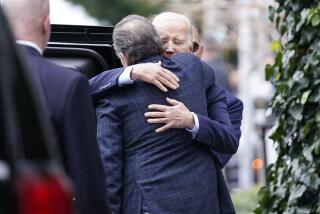Voters in Growing Southern Suburbs May Determine GOP’s ’96 Nominee
- Share via
GREENVILLE, S.C. — To walk from one side to the other in the Commerce Club, on the top floor of the First Union Bank tower here, is to travel in a few steps from this city’s past to its future.
The picture windows in the club’s formal dining room look out to the west, over the Greenville of memory--where the last of the textile mills that once defined this city’s economic, social and political life still stand against the serene backdrop of the Blue Ridge Mountains.
The windows in the club’s bar face east, toward Greenville’s future: new buildings, new homes, and just beyond sight, the dynamic corridor along I-85 where Michelin has located its North American headquarters and BMW recently began rolling its new Z3 convertible out of a gleaming 1.2-million-square-foot factory across the county line.
Behind the factories and office buildings along the interstate, subdivisions with names such as Spaulding Farm and Pelham Falls are harvesting farmlands into suburbs, replacing cows and rabbits with schools and traffic and the Saturday morning bustle of young families.
“It is wall-to-wall subdivisions,” said Patricia Haskell-Robinson, president of a local real estate firm. “As one would build out, the next would buy up the land and build another one.”
These comfortable suburban communities of breakfast nooks and Jeep Cherokees--and those like them outside of Columbia, S.C., and Atlanta, Orlando and Tampa--have become the cornerstone of the solidifying Republican majority in the South. Once defined by sympathy to white flight, the GOP builds its modern identity in these communities as the bulwark against new taxes. Now these fast-growing, conservative but practical suburbs may play the critical role in selecting the GOP presidential nominee.
“I call them our dominant counties,” said Mike Murphy, the chief strategist for former Tennessee Gov. Lamar Alexander’s presidential campaign. “They are the head that leads these states around, primary-wise.”
On the road to the Republican nomination, the primaries in South Carolina (March 2), Georgia (March 5) and finally Florida (March 12) stand as the crucial contests in the South. In each of these states, Murphy convincingly argues, a band of rapidly developing suburban counties holds the balance of power.
In South Carolina, three such zones together provide about 40% of the vote in a Republican primary: the Greenville-Spartanburg corridor, the suburbs outside the state capital of Columbia, and the communities growing to the north and west of Charleston near the coast.
In Georgia, the dominant Atlanta suburbs of Cobb and Gwinnett counties (home turf to House Speaker Newt Gingrich) together account for nearly one-fourth of the statewide Republican primary vote. In Florida, nearly 40% of the GOP primary vote comes from the vibrant I-4 corridor that runs from Daytona Beach on the Atlantic coast, down past Orlando, through rapidly growing Lake and Polk counties, on into Tampa and St. Petersburg on the west coast and then down I-75 to Sarasota.
From state to state, much more unites than divides the voters in these burgeoning counties.
“When I’m in Gwinnett County, it looks just like the neighborhoods here,” said Knox White, Greenville’s 41-year-old mayor. “And when you walk into one of these houses, the people inside of them might have lived in Gwinnett five years ago.”
These parallels extend beyond the South. Though the houses are older, many communities from Nashua to Portsmouth in southern New Hampshire--where middle managers in high-tech Massachusetts companies have congregated--otherwise have much in common with the suburbs of Greenville. So do the sun-soaked, stucco suburbs of Phoenix in Maricopa County, the heart of the Republican electorate in Arizona, another important early GOP contest.
“The ugly secret to our primary,” Murphy said, “is that these suburbs have a lot more to do with our nominating process than the Christian right does.”
What links these counties are common demographics and the common experience of growth. Each is dominated by middle- to upper-middle-class white voters, many of them baby boomers with children in public schools. All of these counties are growing in population faster than the national average--some explosively faster. And in almost all of them, incomes are rising faster than the nation as a whole.
These counties aren’t immune to the anxieties about the future that now shadow American politics.
Greenville, for instance, has experienced some corporate downsizing that has cost middle managers their jobs, and consolidation in the textile industry continues. But the dominant culture here views these as temporary reversals soon submerged in the reliable flow of growth that has reduced unemployment in the county to just over 2%. Like Los Angeles a decade ago, the problems here are mostly the problems of success: crowded roads and crowded schools.
In Greenville--as in many of these growth suburbs--the economic advance of the past generation still provokes wonder. Thirty years ago, textile jobs that asked little in education and provided little in wages accounted for about 80% of all Greenville employment, says Gerald K. Howard, the local Chamber of Commerce’s vice president for economic development.
Today, he notes, textiles account for only about 1 in 8 jobs in the county, higher-wage new manufacturing jobs have proliferated, white-collar employment has grown, and about 200 foreign companies operate in the region.
Initially, Republicans forged their political beachhead in the Southern suburbs by tapping into the fear of desegregation that prompted white exodus from central cities dominated by African Americans. But while these communities are still predominantly white, opposition to taxes is now the bedrock of GOP allegiance. Resistance is greater to federal than local taxes, but so strong is the anti-tax current that no local officeholder in Greenville has seriously proposed increasing taxes for years, despite widespread agreement that the growth has overwhelmed the roads and schools.
While opposition to taxes is the gateway for any Republican candidate, many voters in these high-growth counties are nonetheless open to an activist conservative government that encourages economic development, emphasizes improvements in the public schools and even attempts to manage the growth.
In these suburbs, the political style is pragmatic and temperate; religious conservatives are powerful (huge evangelical “mega-churches” also follow the interstates in the Sunbelt), but overall, voters in these communities lean more to candidates promising reform than revolution. The model candidate may be Carroll Campbell, South Carolina’s former Republican governor who blended fiscal conservatism with economic development and educational reform.
Alexander, as a former governor with similar priorities, might be a good fit for these voters in the impending primaries--but only if, as Murphy acknowledges, he runs well enough in Iowa and New Hampshire to catch their attention. Texas Sen. Phil Gramm has appeal for the more ideological and religious elements in these communities--but his rough edges repel more secular and centrist suburbanites. The increasing integration of these communities into the international economy cools them on the protectionism associated with conservative commentator Patrick J. Buchanan.
In these neighborhoods of unstinting change, the lure of stability makes Senate Majority Leader Bob Dole a formidable competitor--in the 1988 GOP primary, George Bush’s establishment conservatism carried all of the counties in these growth corridors across South Carolina, Georgia and Florida. The wild card this year is publishing magnate Steve Forbes, whose anti-tax, anti-politician message is turning heads: “He’s got people talking,” said Greenville’s Mayor White. But Forbes’ plan to eliminate the mortgage deduction as part of his flat tax may ultimately alienate young families whose most important investments are their new homes.
It’s still too early to predict who will capture these Southern voters--and their minivan-driving cousins in suburbs outside Phoenix, Denver, Manchester and New York City. But it’s a good bet that the candidate who does win their favor will carry the GOP banner against President Clinton next fall.
The Washington Outlook column appears here every other Monday.
(BEGIN TEXT OF INFOBOX / INFOGRAPHIC)
Counties That Count in ’96
Several counties in key early primary states will play a critical role in selecting the Republican presidential nominee in 1996. These counties are bound by the common experience of growth--in all cases population growth, and in most instances relatively robust income growth. Here is a look at some of these heavily suburban battlegrounds that may determine the outcome in the GOP primary:
*--*
County Pop. growth Share of state Median income 1980-1995 GOP vote* as percentage of U.S. median Hillsborough (N.H.) 26% 25% 121% Maricopa (Ariz.) 58% 64% 97% Greenville (S.C.) 17% 11% 96% Lexington (S.C.) 36% 9% 110% Gwinnett (Ga.) 169% 9% 147% Cobb (Ga.) 75% 14% 137% Orange (Fla.) 59% 5% 97% Hillsborough (Fla.) 36% 5% 92% Pinellas (Fla.) 20% 9% 114%
County 1988 GOP primary winner Hillsborough (N.H.) Bush Maricopa (Ariz.) ** Greenville (S.C.) Bush Lexington (S.C.) Bush Gwinnett (Ga.) Bush Cobb (Ga.) Bush Orange (Fla.) Bush Hillsborough (Fla.) Bush Pinellas (Fla.) Bush
*--*
* Based on turnout in ’94 GOP gubernatorial primaries.
** Arizona did not hold a 1988 GOP presidential primary.
Sources: Population growth and median income are from data compiled by Claritas Inc.
Compiled by Times researchers Rob Cioe and Maloy Moore.
More to Read
Get the L.A. Times Politics newsletter
Deeply reported insights into legislation, politics and policy from Sacramento, Washington and beyond. In your inbox twice per week.
You may occasionally receive promotional content from the Los Angeles Times.










